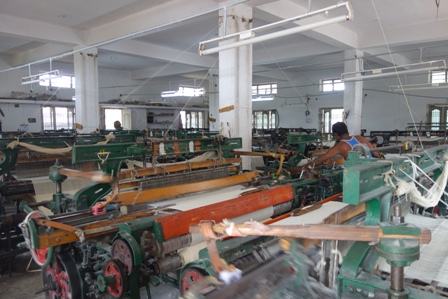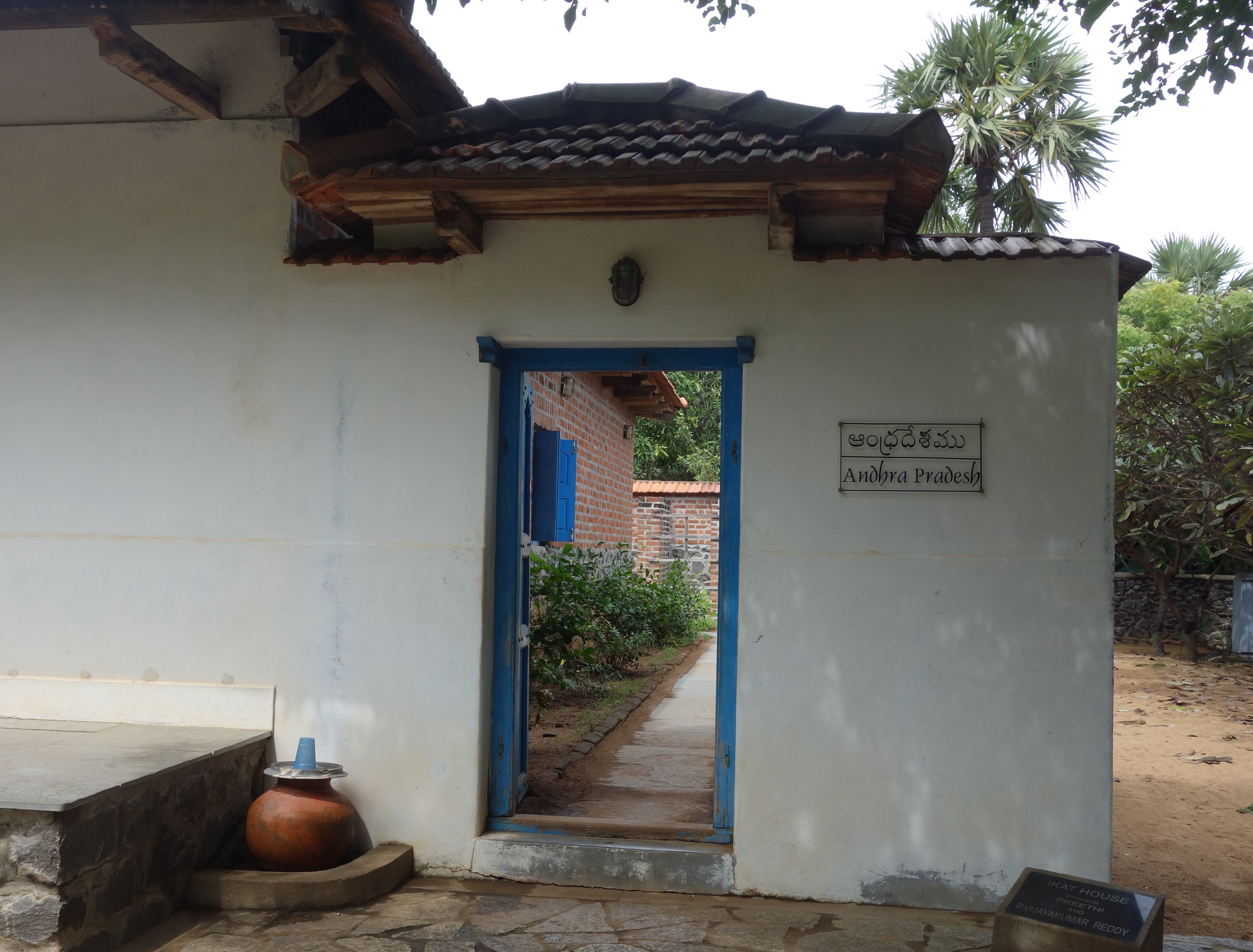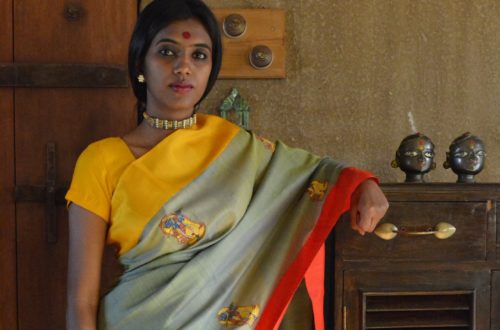In Sircilla, a once thriving handloom town, there are now less than ten weavers, none of them under the age of 70, all looking as if they should have retired long ago. But the term retirement is unknown to weavers. They weave until they can physically weave no longer. There is not a single young handloom weaver here now. But then, where is the incentive to work in handloom when the earnings are just 80-100 rupees a day, while a powerloom weaver earns about 4 – 500 rupees because he can produce so much more? The government are supporting these handloom weavers while they’re still practicing but there is no movement to encourage new entrants to the occupation, so once these weavers have stopped, Sircilla will be a completely powerloom driven town.

The government are providing the yarns (mostly coming from Udyog Bharti in Gondal which I wrote about in a previous post), and giving orders of towels and dhoti cloth which will be sold in government emporiums.

Today 80% of employment in Sircilla comes from the powerloom weaving industry. But the powerloom weavers have not had it easy either. This town’s weavers have been dealt blow after blow all throughout the last century. The industry began in the 1920s when a few men travelled to Sholapur in Maharastra, which drew migrants from all over India to work for its huge weaving industry. They learnt to weave and returned to Sircilla to set up looms and eventually looms were set up in 50 villages around Sircilla. They had a good market in several states in India, particularly Maharastra.
I have referred to the book ‘Threads of Hope: The Magical Weaves of Andhra Pradesh‘ by Noopur Kumar for the following few paragraphs.
By the 1970s, imitations of the Sircilla handloom designs began to appear on powerlooms in Maharastra, sending most of the Sircilla handloom weavers’ businesses plummeting. So the weavers took a loan of over a crore rupees and set up 3000 powerlooms. They were soon mass producing goods such as 25 x 25 counts cotton fabric and 80 x 80 polyester yardage. Weavers worked two shifts seven days a week and produced 70 metres every day. The wide-reach bulk production strategy worked, and orders poured in from Madhya Pradesh, all over Andhra Pradesh, Orissa, Gujarat and Maharastra. In 1990, Sircilla had 800 families owning 12000 looms with 15000 employees in the textiles industry.
In 1991 economic liberalisation dealt a huge blow to the handloom sector. The export of cotton and yarn led to the rise in price of yarn locally and a 9.25% excise duty on cone yarn pushed the price up even further. China and Thailand exported cheap goods to India further damaging the handloom industry. Electricity bills increased. Further, the removal of powerloom from the small scale industry sector paved way for major players in the Gujarat and Maharastra textile industry to step in with their autolooms and modern hhts, unmatched in capacity and productivity. The government of India reduced the customs duty on powerlooms from 15% to 5% and also provided a subsidy on machinery under the technology upgradation fund scheme (TUFS). But this provided no relief to smaller weavers. Maharastra powerloom factories incorporated all allied activities including warping, spinning and dyeing.
A debt relief fund of Rs.10,000 introduced in 1989 only applied to handloom weavers. Being caught between traditional hand industry and large scale mass production industry was the worst place to be, and this is where the Sircilla weavers were positioned.
In the same year, a weaver committed suicide. His family was refused an ex-gratia payment by the government, the reason given by the government official being – he didn’t want to provide an incentive to weavers to take their own lives.
More than 300 weavers and members of their families committed suicide. When Konda Kistaiah and three members of his family died, the incident received unprecedented attention. Leaders of political parties, social workers, television camera-men and press reporters all made a beeline for Rajiv Nagar where Konda Kistaiah lived in Sircilla. The government prompty slashed tariff on electricity from Rs.160 to .87 paisa per unit.

Today 25000 families are dependent on the 23000 looms in Sircilla. Nearly 400,000 metres of white cotton and polyester are woven mainly for petticoats and lehenga sent all over the country. Sircilla has been named ‘the petticoat capital of India’.
I met one family who would buy the white cloth, get it dyed at a dyeing unit nearby, stitched into petticoats by a local tailor, and print it with their brand name. Other than this company, most fabric was exported due to the lack of finishing facilities in the town. For this reason, weavers have no direct access to a market. All the cloth woven is plain white and sent to Bombay for dyeing and/or printing. In one workshop, one man operated 8 looms by himself. He could produce 800 metres in 24 hours (how the family slept through the racket of all these looms running through the night, God knows!).

We did visit a small powerloom unit weaving saris. Only a few looms were in operation. Apparently the weavers missing had drank away most of their wages the night before. The weaves were the same designs woven by handlooms in many parts of Andhra Pradesh – a plain rich colour in the body with simple stripes on the pallu and a dobby jari border. And many traders buying these saris will sell them as ‘handlooms’. I asked whether the weavers would get penalised if any officials found that they were weaving designs that were supposed to be reserved for handlooms. Understandably enough the reply came thus; they would have to be pretty hard-hearted to stop production here for this reason, with all that the industry here has gone through.
It is the traders in Sircilla that have it the best. If prices go up as demand rises, the weavers never see that rise, all profits go the traders. But then this is the story in so many places, which is why the government and non-governmental organisations have stepped in in many places. But at present, there’s not much happening in this vein in Sircilla. Currently the government only supports manufacturing by subsidising power costs and giving loans for the setting up of looms but provide no support in marketing. So Vashu (introduced in the last post), with support from the sector of the government that helped found the Textile Park which houses rapier loom sheds, wants to incorporate a larger scheme that will connect weavers with better markets. Lets see where this goes, and hopefully the future will look much more hopeful and prosperous, whether working on handloom or powerloom, for the weavers of Sircilla.
I am grateful to Vashu for taking me around Sircilla and showing me many different weaving set ups, and also to Gowardhan in Hyderabad for putting me in touch with Vashu.





2 Comments
Greg Roberts
Ruth, many thanks for your comprehensive insights into the very sad decline of the use of the hand loom in Sircilla. It is your emphasis on those remaining weavers and the apparent lack of government support for them, that sadness me greatly and I am sure many around the world. Paradoxically this is happening at a time when consumers are seeking the hand made and knowing where it is made!
Thank you, Greg.
Dear Greg, Thanks for your comment. It was upsetting to see such a dramatic decline of handloom in this region and the very negative impacts of modern fast textile production. I’m glad to have visited though so I can communicate the situation more widely and hope to write more on it, and visit again in the future. Best wishes, Ruth